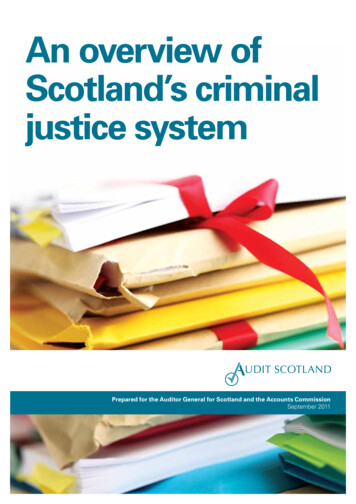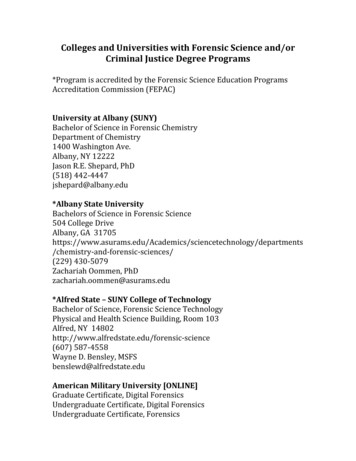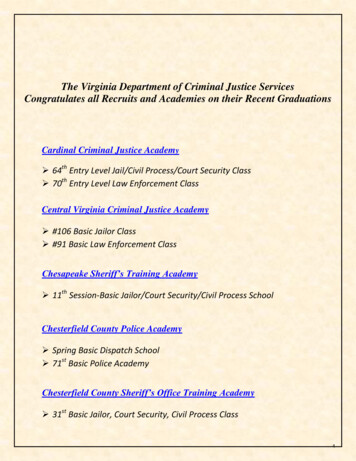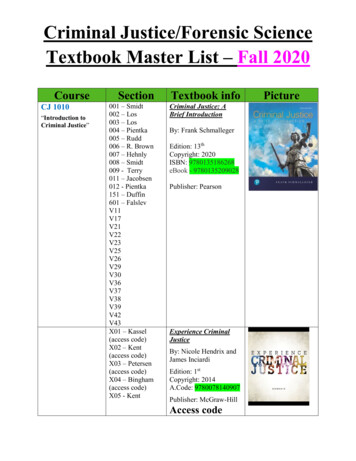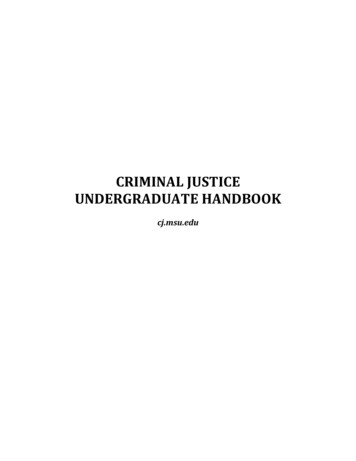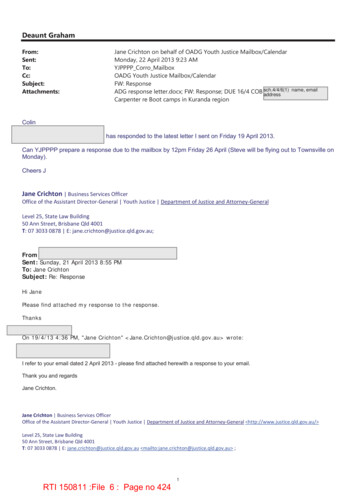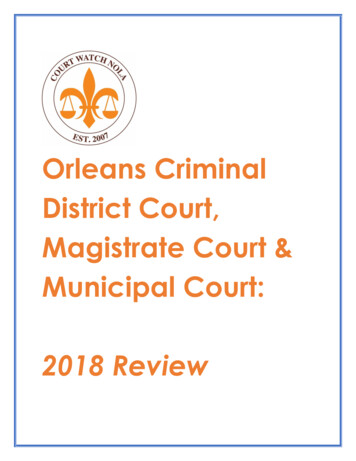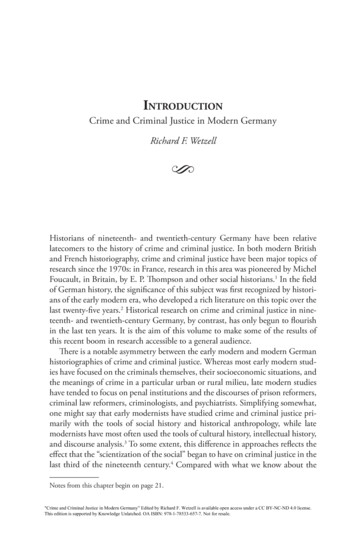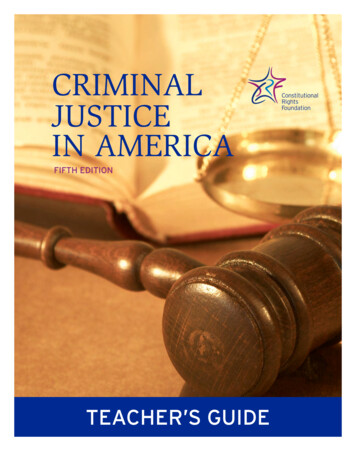
Transcription
cja teachers cover:Layout 18/28/20121:55 PMPage 1CRIMINALJUSTICEIN AMERICAFIFTH EDITIONTEACHER’S GUIDE
CRIMINAL JUSTICEIN AMERICAFIFTH EDITIONTEACHER’S GUIDEDeveloped byBill HayesMarshall Croddy
601 South Kingsley DriveLos Angeles, California 90005(213) 487- 5590www.crf-usa.orgT. Warren Jackson, ChairMarshall P. Horowitz, Chair, Publications CommitteeJonathan Estrin, PresidentMarshall Croddy, Vice PresidentBoard ReviewersMarshall P. Horowitz, Lisa Rockwell, Patrick Rogan, K. Eugene Shutler, Douglas Thompson,Lois ThompsonDeveloped byBill Hayes and Marshall CroddyEditorBill HayesContributing WritersBill Hayes, Sophia Kahn, Adam Leeman, Caitlin W. Meyd, Shruti Modi,Anjelica Grace Sarmiento, Marianna MuratovaDesign and ProductionAndrew CostlyThe development of these materials was financially assisted through the United States Office of JuvenileJustice and Delinquency Prevention, Grant #85-JS-CX-0007.ISBN: 978-1886253-46-7 2012, 2005, 2000, 1998, 1983, 1993, 1991, Constitutional Rights Foundation. All rights reserved.Published in 2012. First Printing. First edition published 1983; second edition, 1991 and 1993;third edition, 2000, fourth edition, 2005.Printed in the United States of America
CRIMINAL JUSTICE IN AMERICATEACHER’S GUIDETABLE OF CONTENTSOverviewSection 1: The TextGoals .4Standards Addressed .5Organization and Content .6Features .7Section 2: Teaching StrategiesDirected Discussion .8Small-Group Learning .8Using Resource Experts .9Quotations .10Peer Teaching .10Handling Controversy .10Field Activities .10Polling Activities .11Briefing Supreme Court Opinions .12Using Editorial Cartoons .12Updating Statistical Charts .12Section 3: Teaching ProceduresInitial Recommendations .13Teaching Sequence .13Introducing the TextUnit 1: CrimeChapter 1: Crimes .15Chapter 2: Defenses .21Chapter 3: Criminals .24Chapter 4: Crime Victims.26Unit 2: The PoliceChapter 5: Police and Society.29Chapter 6: Methods and Investigations .30Chapter 7: Forensic Science .33Chapter 8: Police and the Law .34Chapter 9: The Limits of Police Authority .43Unit 3: The Criminal CaseChapter 10: Courts and the Case Process .45Chapter 11: Investigation and Arrest .48Chapter 12: Pretrial .49Chapter 13: Trial.51Unit 4: CorrectionsChapter 14: Sentencing.54Chapter 15: Prison .57Chapter 16: Alternatives to Prison .60Chapter 17: Capital Punishment.62Unit 5: Juvenile JusticeChapter 18: From Criminal to Delinquent .64Chapter 19: The Problem of Delinquency.65Chapter 20: Children and the Constitution.66Chapter 21: Juvenile Corrections .69Unit 6: SolutionsChapter 22: The Causes of Crime .72Chapter 23: Crime and the Government.73Chapter 24: Crime and the Citizen.75Section 4: Activity MastersList of Activity Masters.770.1 Newsbreak .780.2 Research Activities for Enrichmentand Extra Credit.790.3 Opinion Surveying .800.4 Briefing a Case .820.5 Analyzing an Editorial Cartoon .831.1 Legal-Ease for Unit 1 .841.2 Crime Victim Survey.851.3 Crime Victims Board .862.1 Legal-Ease for Unit 2 .872.2 Application and Affidavit for Search Warrant .882.3 Search Warrant .893.1 Legal-Ease for Unit 3 .903.2 The Prosecutor Decides .913.3 In the Halls of Justice .923.4 Choosing a Jury .943.5 The Defense Rests .954.1 Legal-Ease for Unit 4 .965.1 Legal-Ease for Unit 5 .975.2 Who Should Be in the System? .985.3 Detain or Release .996.1 Legal-Ease for Unit 6 .1006.2 Fighting Crime in the City of Athena (Part 1) .1016.3 Fighting Crime in the City of Athena (Part 2) .102Section 5: Test Masters and Answer KeysPre- and Post-Observations .104Test for Unit 1 .105Test for Unit 2 .107Test for Unit 3 .109Test for Unit 4 .111Test for Unit 5 .113Test for Unit 6 .116Final Test .118Test Answers .121Unit 1 .121Unit 2 .121Unit 3 .122Unit 4 .122Unit 5 .123Unit 6 .124Final Test .124Criminal Justice in America, Fifth EditionTeacher’s Guide3
Welcome to the Fifth Edition of Criminal Justice in America. Both the student book and this teacher’s guide havebeen completely updated and revised. For every chapter and almost every reading, we have resources and linkson our web site. This will provide you and your students with additional sources of up-to-date information. We particularly recommend that you go to the web site to find background information, updated information, the text ofcases cited in the student book, additional information for students doing activities, and activities and resources thatwe have omitted from the student book and placed on our web site. You can also send us your e-mail commentson the book, which will help us with future editions. To get to the Criminal Justice in America page, go towww.CriminalJusticeInAmerica.org. To e-mail your comments, send them to bill@crf-usa.org.OverviewSection 1: The TextThis guide is designed to support the teaching of thematerial contained in Criminal Justice in America. Itprovides information about the text, detailed descriptions of the variety of teaching strategies employed,suggested teaching procedures (including sequences,answers to discussion questions and to activities), activity masters, and chapter and final tests.Criminal Justice in America is the most comprehensiveand interactive introductory text available on the subjects of criminal law, procedure, and criminology. It canserve as a basal text for an entire law-related educationcourse or as a supplement for civics, government, orcontemporary-issues courses. The purpose of this sixunit text is to provide students with an understandingof the criminal justice system and its laws, procedures,and issues. In addition, Criminal Justice in America isdesigned to help students develop critical-thinking andanalytical skills and to assist them in applying the concepts learned in the classroom to real-life situations.It is organized into the following sections:1. The Text. A detailed description of Criminal Justice in America to give the teacher a quickoverview of the purpose, curriculum goals, content, and features of the text.2. Teaching Strategies. A description of the majorteaching strategies utilized in the text providing arationale, teacher tips, and needed preparation forboth inside and outside the classroom.3. Teaching Procedures. Suggested teaching procedures and support materials for each chapter ofthe text organized on a unit-by-unit basis. Eachunit includes: An overview.Objectives.Teaching sequences (which utilize the readings and activities and include suggested answers for dicussion questions, exercises, oractivities). Suggested answers to discussion questions. Suggested answers to class activities.4. Activity Masters. Forms to support various exercises and activities designed for reproduction anddistribution to students.5. Test Masters and Answer Keys. Opinion Master(for pre- and post-surveying of opinions), TestMasters and Answer Keys for each unit and thefinal test.The text uses facts, statistics, and opinions for a balanced and informed presentation of timely issues andpolicies concerning crime and the criminal justice system. Through case studies, simulations, peer-teaching, decision-making, and field activities, studentsclarify public-policy issues, identify values, and propose and evaluate solutions.GoalsThe major goals of Criminal Justice in America are tohelp students:1. Identify the major components of the criminal justice system, including the nature and definition ofcriminal behavior; the role, scope, and limits of lawenforcement; the assumptions and methods of thecriminal case process; the philosophies and alternative methods of corrections; the nature and processesof treating the juvenile offender; the causes of crime;and the role of government and citizens in findingsolutions to America’s crime problems.2.Develop, state, and defend positions on key issuesfacing the criminal justice system, including thetreatment of victims, police-community relations,jury selection, sentencing, capital punishment, thetreatment of juveniles, and the debate over the effectof race and ethnicity at key points in the system.3. Understand major constitutional protections ofdue process and equal protection as reflected inthe processes of criminal justice.4. Evaluate the effect of constitutional provisions oncriminal procedure, including protections againstunreasonable search and seizure, coerced confessions or testimony, cruel and unusual punishment, and the rights of the accused to counseland a fair trial.4Criminal Justice in America, Fifth EditionTeacher’s Guide
5. Understand the function that people play by taking key roles in the criminal justice system, including police, prosecutors, defense lawyers,judges, jurors, court personnel, probation and parole officers, appellate justices, legislators, andspecial-interest groups.habeas corpus, presumption of innocence, fairnotice, impartial tribunal, speedy and publictrials, right to counsel, trial by jury, right againstself incrimination, protection against double jeopardy, right of appeal.6. Understand the role of legislative, executive, andjudicial public policy making and analyze andevaluate public policy options.Understands the advantages and disadvantages ofthe adversary system. . . .7. Identify and analyze our society’s crime problemin terms of its causes, effects, interventions, andstatistical and polemical bases.8. Develop greater capacity to become involved ascitizens to address problems and issues relatingto the criminal justice system at the communitylevel, including assessing opinion and conducting crime-prevention projects.Standards AddressedStandards-based education has arrived. Criminal Justice in America, with its emphasis on critical thinkingand government content, will meet many differentstandards. You will have to check your own state’sand district’s standards. Below are a few nationalstandards that the text addresses. They come from thenational standards for civics and for thinking and reasoning at the high school level.Civics Standards:Understands the sources, purposes, and functions oflaw, and the importance of the rule of law for the protection of individual rights and the common good.Specifically:Knows alternative ideas about the sources of law(e.g., custom, Supreme Being, sovereigns, legislatures) and different varieties of law (e.g., divinelaw, natural law, common law, statute law, international law)Knows alternative ideas about the purposes andfunctions of law (e.g., regulating relationshipsamong people and between people and their government; providing order, predictability, security,and established procedures for the managementof conflict; regulating social and economic relationships in civil society)Understands the importance of Americans sharingand supporting certain values, beliefs, and principlesof American constitutional democracy. Specifically:Understands the significance of fundamental values and principles for the individual and society.Understands the role and importance of law in theAmerican constitutional system and issues regardingthe judicial protection of individual rights. Specifically:Understands the importance to individuals and tosociety of major due process protections such asKnows the basic principles of the juvenile systemand the major differences between the dueprocess rights of juveniles and adults.Understands current issues regarding judicial protection of the rights of individuals.Understands the formation and implementation ofpublic policy. Specifically:Knows a public policy issue at the local, state, ornational level well enough to identify the majorgroups interested in that issue and explain theirrespective positionsUunderstands the processes by which public policy concerning a local, state, or national issue isformed and carried outKnows the points at which citizens can monitor orinfluence the process of public policy formationUnderstands why agreement may be difficult orimpossible on [some] issues . . . because of conflicts about values, principles, and interests.Thinking and Reasoning Standards:Understands and applies the basic principles of presenting an argument. Specifically:Understands that when people try to prove apoint, they may at times select only the information that supports it and ignore the informationthat contradicts it.Identifies techniques used to slant information insubtle ways.Identifies the logic of arguments that are basedon quantitative data.Identifies or seeks out the critical assumptions behind a line of reasoning and uses that to judge thevalidity of an argument.Understands that to be convincing, an argumentmust have both true statements and valid connections among them.Uses tables, charts, and graphs in constructingarguments.Evaluates the overall effectiveness of complexarguments.Criminal Justice in America, Fifth EditionTeacher’s Guide5
Effectively uses mental processes that are based onidentifying similarities and differences (compares,contrasts, classifies). Specifically:Identifies abstract patterns of similarities and differences between information on the same topicbut from different sources.Identifies abstract relationships between seemingly unrelated items.Identifies the qualitative and quantitative traits(other than frequency and obvious importance)that can be used to order and classify items.Applies basic trouble-shooting and problem-solvingtechniques. Specifically:Engages in problem finding and framing for personal situations and situations in the community.Represents a problem accurately in terms of resources, constraints, and objectives.Provides summation of the effectiveness of problem-solving techniques.Examines different options for solving problemsof historical importance and determines why specific courses of action were taken.Evaluates the feasibility of various solutions toproblems; recommends and defends a solution.Applies decision-making techniques. Specifically:Analyzes current or pending decisions that canaffect national or international policy and identifies the consequences of each alternative.Evaluates the costs and benefits of various alternatives within a decision.Organization and ContentThe text is divided into six units. Each unit contains several chapters. The following provides a brief overview:INTRODUCTIONThe introduction overviews the content areas of criminal law, procedure, justice, and criminology. Readersare challenged to take an active role in learning aboutthe system.UNIT ONE: CRIMEChapter 1 — Crimes — A basic primer in criminallaw detailing how crimes are classified and defined,what elements constitute a crime, types of crime, anda special focus on homicide, crimes of stealing, inchoate crimes, crimes against the justice system, hatecrimes, and computer crime.Chapter 2 — Defenses — A look at defenses tocrimes, including affirmative defenses such as self-defense, insanity, and entrapment.Chapter 3 — Criminals — An examination of thosewho commit crimes, from the violent street criminal tothe con artist to the white-collar criminal. A special focusis given to how crime is measured and to youth gangs.6Criminal Justice in America, Fifth EditionTeacher’s GuideChapter 4 — Crime Victims — An exploration ofcrime victims and efforts to compensate them andgive them greater rights in the criminal justice system.UNIT TWO: THE POLICEChapter 5 — Police and Society — A look at the history of law enforcement, the structure of local policedepartments, and the day-to-day activities of police.Chapter 6 — Methods and Investigations — An exploration of the methods of policing and investigation,including community policing, suppressing gang anddrug-related violence, chain of custody, eyewitnessidentification, and the use of informants.Chapter 7 — Forensic Science — A look at the origins of forensic science, the growing use of crime labs,and issues about its validity.Chapter 8 — Police and the Law — An examinationof how constitutional doctrines and criminal procedures affect the work of the police with a special focuson the law of search and seizure, interrogations andconfessions, and the exclusionary rule.Chapter 9 — The Limits of Police Authority — Anexploration of the use of force, controversies over allegations of police brutality, racial profiling, corruption in policing, and methods for policing the police.UNIT THREE: THE CRIMINAL CASEChapter 10 — The Courts and Case Process — Anoverview of the court system, special courts, judgesand judicial independence, the role of prosecutors anddefense attorneys, the rights of criminal defendants,the criminal trial adversary process, the use of evidence to establish facts, and the steps of the criminaltrial process.Chapter 11 — Investigation and Arrest — An introduction to the law of arrest and to the hypotheticalcase upon which the unit is based.Chapter 12 — Pretrial — A step-by-step immersioninto pretrial processes and issues, including the role ofthe defense attorney, the first judicial appearance,bail, prosecutorial review, plea bargaining, probablecause and arraignment hearings, and pretrial motions.Chapter 13 — Trial — An in-depth coverage of keysteps of the criminal trial, including the courtroom setting, jury selection, opening statements, the use andrules of evidence, closing arguments, the judge’s instructions, jury deliberations, and the verdict.UNIT FOUR: CORRECTIONSChapter 14 — Sentencing — An exploration of therationales and theories of punishment, a brief history of corrections in America, an examination ofsentencing laws and guidelines, and a review ofcontroversial issues concerning the sentencing ofconvicted defendants.
Chapter 15 — Prison — A look at different types ofprisons, prison conditions and overcrowding, prisonrevolts and violence, policies driving the high rate ofincarceration (such as three-strikes and truth-insentencing laws). Also, a focus on the issues of parole, rehabilitation, and recidivism.Chapter 16 — Alternatives to Prison — An examination of the major alternatives to incarceration including fines, probation, community service, andcommunity-corrections programs.Chapter 17 — Capital Punishment — An examination of the legal and political issues raised by thedeath penalty.UNIT FIVE: JUVENILE JUSTICEChapter 18 — From Criminal to Delinquent — Alook at how a separate system developed for youngoffenders, the underlying assumptions of that system,and how the emphasis from rehabilitation to punishment has shifted over time.Chapter 19 — The Problem of Delinquency — Anexamination of delinquency, status offenses, themajor steps in the juvenile adjudicatory process, andthe initial detention of juveniles.Chapter 20 — Children and the Constitution — Anexploration of the rights of juveniles as protected bykey provisions of the Bill of Rights, how they differfrom those that apply to adult offenders, and a specialfocus on school searches and drug testing.Chapter 21 — Juvenile Corrections — A look insidejuvenile corrections focusing on the various modelsfor placing and treating offenders, the issue of waiving jurisdiction and transferring juveniles to the adultsystem, and court decisions concerning the sentencesof death or life without parole for juveniles, and current controversies and trends.UNIT SIX: SOLUTIONSChapter 22 — The Causes of Crime — An introduction to various theories about the causes of crime andthe debates that they engender.Chapter 23 — Crime and the Government — An examination of the federal and state governments’ rolein finding solutions to the crime problem and debatesover various policy options to reduce crime and to improve the fairness of the criminal justice system.Chapter 24 — Crime and the Citizen — Citizen options and issues relating to becoming involved inhelping address our society’s crime problem, including the history of vigilantism, crime in schools, burglary prevention in the neighborhood, and localpolitical action.FeaturesThe Criminal Justice in America text contains the following features to support teaching of the material:Reading and Directed Discussion — These narrativesections provide background information on the substantive aspects of the criminal justice system: law,procedures, and issues. Each reading is supported bya series of discussion questions to check comprehension, clarify content, and promote analysis and evaluation. In addition, almost all of these narratives leadinto an accompanying high-interest group or individual activity, which forces the learner to grapple withthe material in the reading.Class Activity — A group or individual classroom activity to provide learners with an opportunity to gathermore information on the topic, apply the concepts inthe reading to realistic hypothetical situations, and practice analytical, critical-thinking, and decision-makingskills. Activities have been designed to provide a varietyof learning strategies, including role play, simulation,debate, and research. Many of the activities model reallife criminal justice decision makers dealing with theproblems encountered in their professions: the police,prosecutors, defense attorneys, judges, and probationand parole officers. Others demonstrate the role of legislative, judicial, and executive policy makers whomake, interpret, and enforce the law. (Note: Most activities are labeled “class activity.” Those simply labeled“activity” are optional.)Ask an Expert — A series of activities utilizing outsideresource experts — lawyers, police officers, probationofficers, judges — to find out how the criminal justicesystem works in the real world. In addition, many of thegroup activities lend themselves to having an outside resource person provide additional data and debrief theactivity to compare the processes and decisions in thesimulation with those operating in the local jurisdiction.Special Features in Unit 3: The Criminal Case — Aset of unique features to provide students with a stepby-step guide to the investigative, pretrial, trial, and verdict phases of a criminal case. As well as educatingstudents about the major assumptions, laws, and procedures that govern a criminal trial, the chapter isspecifically designed to help students prepare to participate in a mock trial and intelligently follow local criminal trials as they are reported by the media. Using thehypothetical “drive-by” homicide case of People v.Evans, the chapter includes these additional features:Case Notes provide an ongoing storyline covering thefacts, characters, and drama of the trial.Key Steps outline the law and procedures of the criminal pretrial and trial.Activities put the students into the shoes of the trial’skey players — prosecutors, defense attorneys, judges,and jurors — to make the arguments and decisions tosettle the fate of the defendant.Special Internet Features — The ConstitutionalRights Foundation web site has resources and linksfor every chapter of the book. Go to:www.CriminalJusticeInAmerica.org.Criminal Justice in America, Fifth EditionTeacher’s Guide7
Section 2:TEACHING STRATEGIESGood teaching engages the learner with interactivelearning strategies, such as directed discussion, roleplay, simulation, debate, and research. Criminal Justice in America utilizes all of these methods and features special applications modeling virtually every keyprocedure in the criminal justice system: mock trialsand hearings, legislative and policy-making bodies,and decision-making functions of prosecutors, defense attorneys, jurors, judges, probation officers, andparole boards.In addition, Criminal Justice in America provides models for taking the learning process outside the classroom into the community. It contains opportunities formaking field visits to criminal justice institutions suchas courts and police facilities, conducting and analyzing opinion polls, doing outside research, and conducting crime prevention and police-communityprojects. These activities not only promote servicelearning, they also help students compare the theoretical to actual practices and learn about specific lawsand procedures that apply to their own jurisdiction.In reviewing the materials, note that instructions forconducting the various activities are built into thetext. It is important that the teacher utilize as many ofthese learning opportunities as possible. They are designed to: Improve comprehension and concept building bygiving the learner the opportunity to review thecontent covered and apply it to a problem or hypothetical situation in a meaningful and challenging way. Develop analytical and critical-thinking skills bymaking inferences, evaluating evidence, predicting consequences, weighing benefits and costs,identifying and generating alternatives, and stating and supporting opinions and decisions. Connect the theoretical and abstract learning ofthe classroom to real-world domains of issue-oriented citizenship, including those of political andinstitutional decision making, policy formulation,and political participation.The following is a brief guide to help teachers planfor and utilize the major teaching strategies employedin the text. It is recommended that teachers reviewthese general guidelines before conducting the various strategies and refer back to them as required.Directed DiscussionDirected discussion is an essential part of classroomlearning and especially important in civic and law-relatededucation. It gives the learner an opportunity to checkcomprehension of the material, compare observationswith other classmates, practice communication, develop8Criminal Justice in America, Fifth EditionTeacher’s Guideconfidence, and practice higher-order analytical and criticalthinking skills. Each reading in the text is supported byquestions to help teachers conduct directed discussions about the major terms and concepts it contains.Sample answers for more technically oriented andhigher-order questions are provided for guidance. Depending on the skill levels of the class, the teachermay wish to add and ask additional questions, asnecessary.In discussing a reading or debriefing an activity, it isalways important to employ effective questioningtechniques, including proper “wait time,” appropriateverbal and non-verbal cues, and necessary followup. It is also important that all students get the opportunity to answer questions, which may requirecalling on less assertive learners, as necessary.When a question calls for a personal opinion, encourage students to: Clearly state their opinion. Support it with facts, logical arguments, or references to parallel situations and circumstances. Clearly define the terms they use.This will give students practice in stating and givingreasoned support for their opinions. It will also develop criteria by which students can judge the opinions of others.Small-Group LearningCooperative and small-group learning give studentspractice in communication, participation, teamwork, bargaining, sharing, and compromise. In addition, these strategies help students of all abilitylevels learn more effectively. Research also hasdemonstrated that cooperative learning, in particular, improves comprehension and conceptual learning. Dozens of small-group and class activities areincorporated into Criminal Justice in America. Manylend themselves to cooperative learning and teachers are encouraged to apply these techniques. To facilitate their use, the procedural steps of conductingthe various activities are detailed in the text.In general, to maximize
Criminal Justice in America, Fifth Edition 5 Teacher’s Guide 5. Understand the function that people play by tak-ing key roles in the criminal justice system, in-cluding police, prosecutors, defense lawyers, judges, jurors, court personnel, probation and pa-role officers, appella
